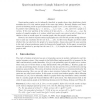Free Online Productivity Tools
i2Speak
i2Symbol
i2OCR
iTex2Img
iWeb2Print
iWeb2Shot
i2Type
iPdf2Split
iPdf2Merge
i2Bopomofo
i2Arabic
i2Style
i2Image
i2PDF
iLatex2Rtf
Sci2ools
CORR
2010
Springer
2010
Springer
Quasi-randomness of graph balanced cut properties
Quasi-random graphs can be informally described as graphs whose edge distribution closely resembles that of a truly random graph of the same edge density. Recently, Shapira and Yuster proved the following result on quasi-randomness of graphs. Let k 2 be a fixed integer, 1, . . . , k be positive reals satisfying i i = 1 and (1, . . . , k) = (1/k, . . . , 1/k), and G be a graph on n vertices. If for every partition of the vertices of G into sets V1, . . . , Vk of size 1n, . . . , kn, the number of complete graphs on k vertices which have exactly one vertex in each of these sets is similar to what we would expect in a random graph, then the graph is quasi-random. However, the method of quasi-random hypergraphs they used did not provide enough information to make any conclusion for the case (1/k, . . . , 1/k). In their work, Shapira and Yuster asked whether this case also forces the graph to be quasi-random. Janson also posed the same question in his study of quasi-randomness under the f...
| Added | 09 Dec 2010 |
| Updated | 09 Dec 2010 |
| Type | Journal |
| Year | 2010 |
| Where | CORR |
| Authors | Hao Huang, Choongbum Lee |
Comments (0)

